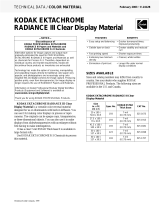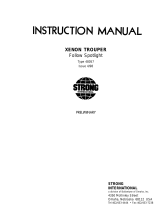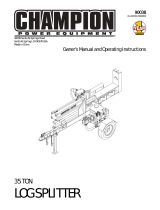
©Eastman Kodak Company, 1998
June 1998 • H-1-5272
TECHNICAL DATA /
COLOR INTERMEDIATE FILM
EASTMAN Color Internegative II
Film 5272
™
/ 7272
™
DESCRIPTION
EASTMANColorInternegativeIIFilm5272(35mm)and
7272 (16 mm) is a medium-speed film with excellent
image-structure characteristics and color-correction
masking. It is intended for making 35 mm or 16 mm
internegatives from reversal color originals on
EASTMAN EKTACHROME Film 7240™. This film is
balanced for printing with tungsten illumination with
suitablefiltersinthelightpath.Theinternegativescanthen
beprinted onto KODAKColorPrint Film and EASTMAN
EXR Color Print Film.
BASE
This film has a clear acetate safety base with rem-jet
backing.
DARKROOM RECOMMENDATIONS
Do not use a safelight. Handle unprocessed film in total
darkness.
STORAGE
Store unexposed film at 13˚C (55˚F) or below. Process
exposed film promptly. Store processed film at 21˚C
(70˚F) or lower at a relative humidity of 40 to 50 percent
for short-term commercial storage; for long-term storage,
store it at 2 to 10˚C (35 to 50˚F) at 15- to 30-percent
humidity. For more information on long-term storage, see
KODAK Publication H-23, The Book of Film Care.
RECIPROCITY CHARACTERISTICS
You do not need to make any exposure or filter
adjustments for exposure times from 1/1000 to 1/10
second. For exposure time of either 1 or 5 seconds,
increase exposure by
1
⁄
2
stop and use a KODAK Color
Compensating Filter 10Y.
PROCESSING
Most commercial motion-picture laboratories provide a
processing service for this film. Pre-packaged kits are also
available for preparing the processing solutions. For more
information on the EASTMAN ECN-2 Kit Chemicals,
check Kodak’s Professional Motion Imaging Price
Catalog or see a Kodak sales representative in your
country. See KODAK Publication No. H-24, Manual for
Processing KODAKMotionPictureFilms,Process ECN-2
Specifications, Module 7, for more information on the
solution formulas and the procedures for continuous
machine processing this film.
IDENTIFICATION
After processing, the product code numbers 5272 and
7272; emulsion and roll number identification;
EASTMAN KEYKODE Numbers; and a film
identification code (S) are visible along the length of the
film.

2 EASTMAN Color Internegative II Film 5272
™
/ 7272
™
• H-1-5272
LABORATORY AIM DENSITY (LAD)
CONTROL METHOD
To maintain optimum quality and consistency in the final
prints, the laboratory must carefully control the color
timing, printing, and duplicating procedures. Laboratory
Aim Density (LAD) Control Film provides a simple,
effective, and easily implemented control method for the
production of master positives and duplicate negatives
from negative originals.
All film in the printing original should be color timed
relative to LAD Control Film supplied by Eastman Kodak
Company. The reversal LAD control film specified may
be made on EASTMAN EKTACHROME Film 7240
flashed and processed to Status M densities of Red 1.10,
Green 1.10, and Blue 1.10. The LAD Control Film is
printed at the center of the printer range, usually
TAPE 25-25-25. Printer setup (speed, bulb voltage,
TRIM, filtration, etc.) is determined by printing the large
gray patch in the LAD Control Film to the specified
Laboratory Aim Density values on the duplicating film,
chosentobeatthecenteroftheusablestraight-lineportion
of the duplicating film’s characteristic curves. The Status
M Laboratory Aim Density values for EASTMAN Color
Internegative II Film are as follows:
Formakingprints,theprocessedinternegativemaythen
be timed relative to a negative LAD Control Film using
densitometry or an electronic color analyzer. On-aim
internegatives and duplicate negatives will normally time
near TAPE 29-29-29 compared to the negative LAD
Control Film printed at TAPE 25-25-25. The LAD on the
print film is a neutral gray of 1.0 visual density. The LAD
Control Method
*
assumes that the film and process
sensitometry are within specification.
Red Green Blue Tolerance
0.90 1.30 1.70 ± 0.12 density
* The LAD control method is described in the paper “A Simplified
Motion-Picture Laboratory Control Method for Improved Color
Duplication,” by John P. Pytlak and Alfred W. Fleischer in the
October 1976SMPTEJournal. Alsorefer toKODAK PublicationNo.
H-61, LAD—
Laboratory Aim Density
.
PRINTING CONDITIONS
In all printer setups for printing EASTMAN Color
InternegativeII Film5272 / 7272,include a heat absorbing
(infrared) filter such as a KODAK Heat Absorbing Glass,
No. 2043, and a KODAK WRATTEN Gelatin Filter No.
2B to absorb ultraviolet (UV) light. For high light output
with very long bulb life, operate the printer bulb at
approximately 80 percent of rated voltage. Use a
well-regulated constant-current dc power supply.
Print the LAD Control Film at the center of the printer
balance range, usually TAPE 25-25-25 on an additive
printer. Print other scenes in the original as determined by
color timing relative to the reversal LAD Control Film.
Choose the printer speed and filtration to normalize the
additive TRIM settings near the center of their range to
allow for slight variations in film and printer.
On subtractive printers, choose the filter pack and light
control for both the removal and addition of filters for
color correction. You can use EASTMAN Lamphouse
ModificationFilters in subtractive printersto more closely
balance the spectral characteristics of subtractive
lamphouses with additive lamphouses so that prints made
on a subtractive printer more closely match those made on
additive printers. On optical printers, set the lens aperture
considering sharpness, depth of focus, and light
transmittance characteristics. Use ground glass or other
diffusers to improve uniformity of illumination.Clean and
align optics for optimum light output and uniformity.
IMAGE STRUCTURE
The modulation-transfer curve, rms granularity, and
resolving-power data were generated from samples of
EASTMANColor NegativeII Film exposedwith tungsten
light and processed as recommended in Process ECN-2
chemicals. For more information on image-structure
characteristics,seeKODAK PublicationNo.H-1,KODAK
Professional Motion Picture Films.
Diffuse RMS Granularity
*
Less than 5
* Read at a net diffuse visual density of 1.0, using a 48-micrometre
aperture.
Resolving Power
†
† Determined according to a method similar to the one described in
ISO 6328-1982,
Photography—Photographic Materials—
Determination of ISO Resolving Power.
TOC 1.6:1
TOC 1000:1
80 lines/mm
160 lines/mm

EASTMAN Color Internegative II Film 5272
™
/ 7272
™
• H-1-5272 3
Characteristic Curves
Spectral-Dye-Density Curves
Note: While the data presented are typical of production
coatings, they do not represent standards which must be met
by Kodak. Varying storage, exposure, and processing
conditionswillaffectresults. The company reserves the right
to change and improve product characteristics at any time.
F010_0049AC
KODAK WRATTEN Gelatin Filter No. 2B
with KODAK Heat Absorbing Glass, No. 2043,
3.0
R
G
B
Status M
Tungsten (2850 K), 1/100 second
ECN-2
Process:
Exposure:
Densitometry:
2.01.0
4.0
3.0
2.0
1.0
DENSITY
0.0
0.0
1.0
LOG EXPOSURE (lux-seconds)
F010_0051AC
650450350
0.0
250
WAVELENGTH (nm)
550
DIFFUSE SPECTRAL DENSITY
1.0
0.5
2.0
1.5
2.5
750
Typical densities for a midscale neutral subject
and D-min.
ECN-2
Process:
Midscale Neutral
Minimum Density
Spectral-Sensitivity Curves
Modulation-Transfer Curves
These photographic modulation-transfer values were
determined by using a method similar to the one described in
ANSIStandardPH2.39-1977(R1990).Thefilm was exposed
with the specified illuminant to spatially varying sinusoidal
test patterns having an aerial image modulation of a nominal
60 percent at the image plane, with processing as indicated.
In most cases, the photographic modulation-transfer values
are influenced by development-adjacency effectsand are not
equivalent to the true optical modulation-transfer curve of
the emulsion layer in the particular photographic product.
700 750650600550500450400350300250
*Sensitivity = reciprocal of exposure (ergs/cm ) required
to produce specified density
WAVELENGTH (nm)
2
LOG SENSITIVITY
3.0
*
2.0
1.0
0.0
1.0
1.0 above D-min
1.4 second
Process:
Effective Exposure:
Densitometry:
ECN-2
Density:
Status M
Yellow-
Forming
Layer
Magenta-
Forming
Layer
Cyan-
Forming
Layer
F010_0050AC
1001 2 3 4 5 10 20 50 200 600
SPATIAL FREQUENCY (cycles/mm)
RESPONSE (%)
10
1
2
5
3
7
30
20
100
70
50
200
F010_0048AC
Densitometry:
Exposure:
Process:
ECN-2
Tungsten
Diffuse Visual

EASTMAN Color Internegative II Film 5272
™
/ 7272
™
Professional
Motion Imaging
EASTMAN Color Internegative II Film
5272
™
/ 7272
™
KODAK Publication No. H-1-5272
CAT 826 1851
Major Revision 6-98
Printed in U.S.A.
AVAILABLE ROLL LENGTHS
For information on film roll lengths, check Kodak’s
Professional Motion Imaging Price Catalog or see a
Kodak sales representative in your country.
KODAK
LOCATIONS
FOR DIRECT ORDERING IN THE UNITED STATES:
1-800-621-FILM
ATLANTA, GEORGIA
4 Concourse Parkway
Suite 300
Atlanta, Georgia 30328-5379
Information: 800-800-8398
CHICAGO, ILLINOIS
815 West Van Buren, Suite 320
Chicago, Illinois 60607
Information: 312-492-1423
DALLAS, TEXAS
11337 Indian Trail
Dallas, Texas 75229
Information: 972-481-1150 or 312-492-1423
HOLLYWOOD, CALIFORNIA
6700 Santa Monica Boulevard
P. O. Box 38939
Hollywood, California 90038-1203
Information: 323-464-6131
NEW YORK, NEW YORK
360 West 31st Street
New York, New York 10001-2727
Information: 212-631-3450
FOR DIRECT ORDERING IN CANADA:
1-800-465-6325
KODAK On Line At:
http://www.kodak.com/go/motion
MONTREAL, CANADA
Kodak Canada Inc.
4 Place du Commerce
Ile des Soeurs
Verdun, Quebec, H3E 1J4, Canada
Information: 514-761-3481
TORONTO, CANADA
Kodak Canada Inc.
3500 Eglinton Avenue West
Toronto, Ontario, M6M 1V3, Canada
Information: 416-766-8233
VANCOUVER, CANADA
Kodak Canada Inc.
4185 Still Creek Drive
Burnaby, British Columbia, V5C 6G9, Canada
Information: 604-320-1777
Kodak, Eastman, Ektachrome, Keykode, Wratten,
5272, 7240, and 7272, are trademarks.
-
 1
1
-
 2
2
-
 3
3
-
 4
4
Ask a question and I''ll find the answer in the document
Finding information in a document is now easier with AI
Related papers
Other documents
-
Polaroid T-64 User manual
-
Polaroid T-600 User manual
-
Vestil LAD-PW Owner's manual
-
 Furitechnics KODAK E-2412B User manual
Furitechnics KODAK E-2412B User manual
-
 Strong Enterprises 48057 User manual
Strong Enterprises 48057 User manual
-
AgfaPhoto 6A4360 Datasheet
-
Vestil LAD-RAF Owner's manual
-
Fujifilm 16010320 Datasheet
-
Vestil LAD-MM Series Owner's manual
-
 Champion Power Equipment 90038 User manual
Champion Power Equipment 90038 User manual






